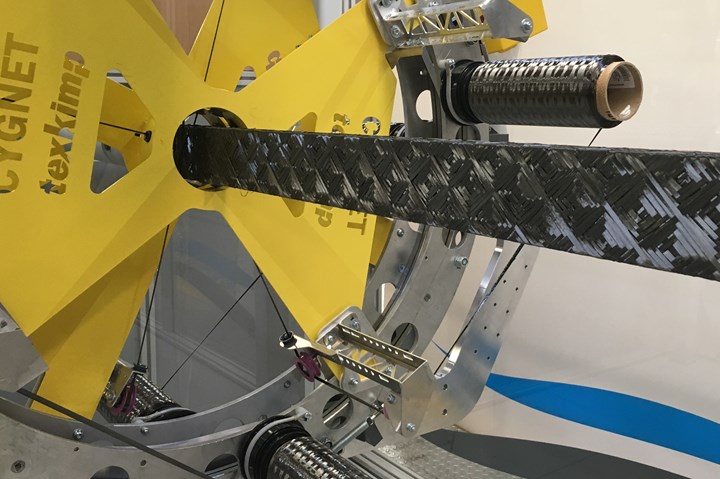NWCC, Cygnet Texkimp collaboration to advance data on winding capability for composite parts
Research project to demonstrate damage tolerance and impact resistance of composite parts manufactured with new multi-axis winder and 3D winding technologies for further development and commercialization.

Cygnet Texkimp multi-axis winder. Photo Credit: Cygnet Texkimp.
The Northwest Composites Centre (NWCC, Manchester, U.K.), which is part of the University of Manchester’s Department of Materials, and composites technology company Cygnet Texkimp (Northwich, U.K.) have announced a new research project that will demonstrate the damage tolerance and impact resistance of composite parts manufactured using Cygnet Texkimp’s multi-axis winder (MAW) and 3D winder technologies compared to parts created using braiding and conventional filament winding.
The research will be undertaken by the National Composites Certification and Evaluation Facility (NCCEF), the commercial arm of the Northwest Composites Centre which provides independent, accredited testing and qualifying services to the aerospace, automotive, oil and gas, marine and wind energy industries, including all major primes and Tier 1 and 2 suppliers.
The 3D winder is a robot-mounted, multi-axis, high-speed winding machine. Launched in 2018, Cygnet Texkimp contends that it is the first winding technology of its kind capable of laying down high fiber volumes quickly and accurately to manufacture complex, curved composite components that are strong and repeatable.
The MAW, launched in January 2021, reportedly uses rotating rings to lay down large volumes of material at high speed around a static mandrel. This technology is a development of the 3D winder, says Cygnet Texkimp, but has been optimized for throughput and designed to manufacture long, straight, continuous composite parts with angles and slight curves, including aircraft wing spars, crash protection structures, fuel pipes, tubes, masts and other profiles.
The NWCC has been awarded funding and resources from The Engineering and Physical Sciences Research Council (EPSRC, U.K.) Impact Acceleration Account to carry out and showcase the results of its work.
“The multi-axis winder and the 3D winder are both very new and innovative technologies,” explains Dr. Yan Liu, R&D specialist at Cygnet Texkimp. “Engaging the rigor of a respected, external testing body will help us to gather valuable data and demonstrate their uses and benefits to the industry with the aim of accelerating their adoption.
“We are confident that they [the multi-axis and 3D winder] offer unparalleled levels of speed and throughput at reduced capital cost,” Liu continues. “What the NWCC research will also show us is where these techniques sit in the process hierarchy in terms of the strength and impact resistance of the finished part.”
The project will be led by Professor Potluri, director of the NWCC. Researchers will take a range of composite parts manufactured on the MAW, 3D winder, a braider and a conventional filament winder and carry out a series of tests, including four-point bending, impact and bending after impact testing, to investigate how strength and damage tolerance are affected by the manufacturing technique.
“Using science to investigate and compare manufacturing techniques is increasingly important as composites manufacturers and end-users look for better and more efficient ways to create high performance materials and parts,” says Professor Potluri. “Trials like these are extremely useful not only to validate new technology but to give commercial customers the insights to select the right technology for their business. The main purpose of our research is to quantify how structural performance and damage tolerance can be maximized, depending on the method of manufacture employed.”
This is the second time the two organizations have worked together. In 2018, both took part in a Knowledge Transfer Partnership, which focused on a nine-axis winding concept first developed by Professor Potluri. That technology was further developed and commercialized by Cygnet Texkimp to create the 3D winder.
“The University has a key role to play at the interface between academia and industry, supporting the commercialization of innovative concepts that have the potential to transform manufacturing,” says Professor Potluri. “Combining our knowledge and resources with those of a world-class company like Cygnet Texkimp means that together our work can have a real and positive impact on the industry.”
Cygnet Texkimp CEO Luke Vardy will present findings from the research project as part of the CW Tech Days: Composites in the Hydrogen Economy, exploring the role of 3D winding technology in the manufacture of hydrogen storage tanks, May 18, 2021.
Related Content
ASCEND program update: Designing next-gen, high-rate auto and aerospace composites
GKN Aerospace, McLaren Automotive and U.K.-based partners share goals and progress aiming at high-rate, Industry 4.0-enabled, sustainable materials and processes.
Read MorePlant tour: BeSpline/Addcomp, Sherbrooke, QC, Canada
Composites automation specialist increases access to next-gen technologies, including novel AFP systems and unique 3D parts using adaptive molds.
Read MorePlant tour: Avel Robotics, Lorient, France
From AFP hydrofoils to more efficient aircraft parts, Avel uses digital design, multiprocess production and a rule-breaking approach for complex 4D composites.
Read MoreThermoset-thermoplastic joining, natural fibers enable sustainability-focused brake cover
Award-winning motorcycle brake disc cover showcases potential for KTM Technologies’ Conexus joining technology and flax fiber composites.
Read MoreRead Next
VIDEO: High-rate composites production for aerospace
Westlake Epoxy’s process on display at CAMX 2024 reduces cycle time from hours to just 15 minutes.
Read MorePlant tour: A&P, Cincinnati, OH
A&P has made a name for itself as a braider, but the depth and breadth of its technical aptitude comes into sharp focus with a peek behind usually closed doors.
Read More“Structured air” TPS safeguards composite structures
Powered by an 85% air/15% pure polyimide aerogel, Blueshift’s novel material system protects structures during transient thermal events from -200°C to beyond 2400°C for rockets, battery boxes and more.
Read More


























